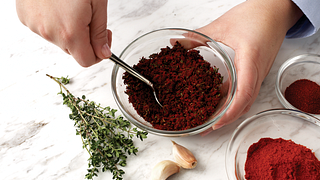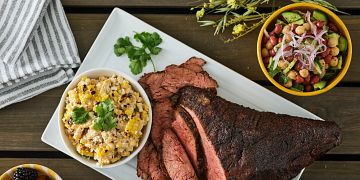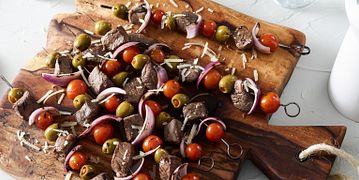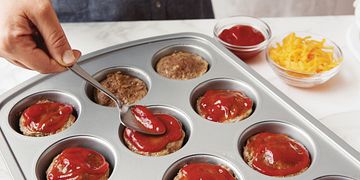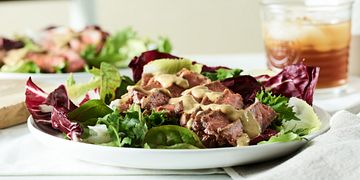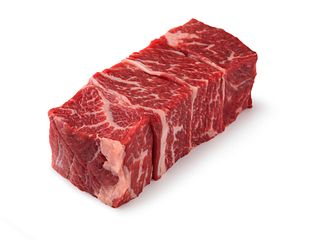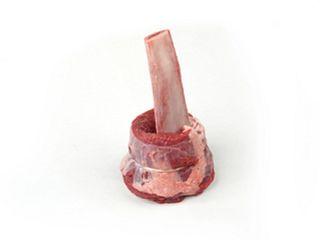Smoking Basics
To many who appreciate the art of smoking meat, it’s referred to as “barbecue,” “bar-b-q,” or just simply as “BBQ.” But by any name, this timeless technique delivers richly-flavored, luxuriously tender results.
Smoking basics
Large cuts such as Brisket, Roasts and Ribs are prime candidates for smoking, but even a Ground Beef burger can benefit from a hint of smoke. Whichever cuts you choose, always remember that time, patience and practice pay off — don’t be afraid to tweak your technique to suit your tools and tastes.
Prep the smoker
Whether you’re using a classic smoker, kamado (ceramic, typically egg-shaped) grill, traditional kettle grill or electric smoker, you’re still applying the same basic elements: indirect heat, wood smoke and time. Follow the guidelines for your type of smoker, and if your smoker’s heat source is directly below the meat, use a drip-pan to prevent flare-ups and avoid producing too much smoke, which can lead to bitter taste. Always work in an open, well-ventilated space.
what wood you do?
With smoking, the wood itself is an essential part of any recipe. Different hardwoods produce different results, from the deeper smoky flavor of mesquite to the mild sweetness of apple wood to the versatility of hickory. Some aficionados say it’s essential to soak hardwoods before smoking so they’ll burn longer, while others believe soaked wood won’t produce enough clean smoke. Likewise, wood may be smoked in logs, chunks, chips or pellets. Follow the guidelines for your recipe, but feel free to experiment.
bring the heat
Just as there are many options to consider with both smokers and hardwoods, the heat source is also an important factor. Serious ‘cuers swear by lump charcoal, which contains only burnt wood, burns hotter and longer, and produces a flavorful smoke. Briquettes are commonly used as well, and are particularly effective when employing the “snake” method, similar to a long-burning fuse. Other heat sources include propane gas and a simple flip of the switch, when using an electric smoker.
rub it up
While most of the flavor will come from the smoke and beef, seasoning rubs can blend nicely with the natural flavor of the wood. Rubs can be wet or dry, spicy or sweet, bold or subtle, or just basic salt and pepper. Whichever you choose, keep in mind it’s called a rub for a reason: Don’t be afraid to get hands-on and work the rub into the surface of the meat to get the most flavor (and prevent it from falling off). Rubs can be applied just before you begin smoking or hours in advance and refrigerated until it’s time to get started.
low and (real) Slow
Although a flavorful touch of smoke can be achieved in an hour or less, larger and less tender cuts will generally need to be smoked up to 12 hours or more. Specific times and temps depend on the cut and intended results, so refer to your recipe.
Wood Types For SMoking
Wood Type |
Flavor Profile |
|---|---|
| Hickory | Provides a sweet, savory and hearty flavor to the beef. One of the more popular woods due to its strong flavor. |
| Mesquite | Will give a very smoky flavor and is great for cooking smaller cuts during a shorter period of time. |
| Oak | One of the more common woods used for smoking. Has a subtle flavor that is great for cooking larger cuts as it won’t be too overpowering. |
| Apple | Will provide a sweeter taste and mild fruitiness. Great for mixing in with another wood type or by itself. |
| Pecan | Provides a rich, sweet, nutty flavor to the beef. Great as a mix in since it can tend to be sweeter. |
| Cherry | Offers a hint of fruitiness to the beef and is great used by itself or mixed with another wood. |
| Maple | Will give the meat a sweet, light and mild smokiness flavor. Great for mixing with other wood or by itself. |
Need a new method for cooking that beef brisket? Pitmaster Rasheed Philips walks through the benefits of the Texas Crutch.
Glossary
Smoke Ring
The badge of honor,
the money maker, the holy grail — this pink layer near the meat’s surface,
caused by a chemical reaction to wood smoke, is a can’t-miss sign of great
barbecue.
brisket seasoning tips
Chuck Short Ribs, Boneless
A crowd favorite, known for their richness and meatiness. Flavorful, moist and tender when slow-cooked.
Short Rib Osso Bucco
Long-bone short ribs cut and tied for an osso bucco style presentation.
Brisket Flat Half
The leaner half of the whole Brisket also known also as the “first cut,” this full-flavored meat can be sliced or shredded.
Coulotte Roast
With plenty of marbling, this is a juicy and savory roast. Best roasted in the oven or smoked slowly on the grill.

grilling favorites
It's always time to fire up the grill and we’ve got just what you’re looking for. Whether you want a classic burger or a spice-rubbed steak with a side of grilled fruit, this collection won’t disappoint.
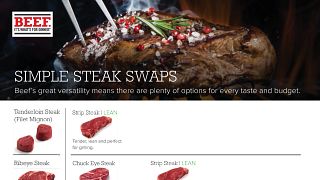
Simple steak swaps
New quick guide to steak cuts highlights beef’s versatility with options for every taste and budget to help consumers looking to try something new at the meat case.

the tastiest burgers
What better way to say hello to Summer and Grilling season with an all time classic: the burger. This collection has all the between-two-buns deliciousness you could imagine.

grilling season facts
Wonder what everybody else is cooking this grilling season? You're in luck... learn what America is grilling!

